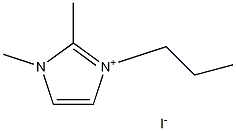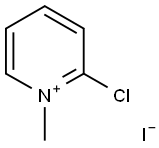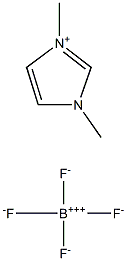1,3-DIMETHYLIMIDAZOLIUM DIMETHYL PHOSPHATE
Synonym(s):[MMIM][DMP];1,3-Dimethylimidazolium dimethylphosphate
- CAS NO.:654058-04-5
- Empirical Formula: C7H15N2O4P
- Molecular Weight: 222.18
- MDL number: MFCD08275369
- EINECS: 200-100-5
- SAFETY DATA SHEET (SDS)
- Update Date: 2024-11-14 14:09:35

What is 1,3-DIMETHYLIMIDAZOLIUM DIMETHYL PHOSPHATE?
The Uses of 1,3-DIMETHYLIMIDAZOLIUM DIMETHYL PHOSPHATE
1,3-Dimethylimidazolium dimethyl phosphate ([MMIM][DMP]) can be used as a catalyst and a solvent for the preparation of ethyl 2-cyano-3-phenylpropenoate from benzaldehyde and ethyl cyanoacetate via Knoevenagel condensation. It can also be used to produce bioethanol from sugarcane bagasse by enzymatic hydrolysis.
The Uses of 1,3-DIMETHYLIMIDAZOLIUM DIMETHYL PHOSPHATE
It is an important raw material and intermediate used in organic synthesis, pharmaceuticals, agrochemicals and dyestuffs. ionic liquid 1,3-dimethylimidazolium dimethylphosphate ([MMIM][DMP]) + water/ethanol/methanol mixtures exhibit properties which render them suitable as candidates for working pairs in industrial applications of absorption heat pumps or chillers.
General Description
1,3-Dimethylimidazolium dimethyl phosphate is an imidazolium-based phosphoric ionic liquid that can be prepared by reacting 1-methylimidazole with trimethyl phosphate. The pretreatment of sugarcane bagasse with [MMIM][DMP] yields glucose and xylose via enzymatic saccharification.
Properties of 1,3-DIMETHYLIMIDAZOLIUM DIMETHYL PHOSPHATE
| Melting point: | <-65℃ |
| Density | 1.277 |
| refractive index | n20/D 1.486 |
| storage temp. | Inert atmosphere,2-8°C |
| form | clear liquid |
| color | Light orange to Yellow to Green |
| PH | 2.4 (H2O, 20℃) |
| Water Solubility | Insoluble in water. |
Safety information for 1,3-DIMETHYLIMIDAZOLIUM DIMETHYL PHOSPHATE
| Signal word | Danger |
| Pictogram(s) |
 Corrosion Corrosives GHS05 |
| GHS Hazard Statements |
H314:Skin corrosion/irritation |
| Precautionary Statement Codes |
P280:Wear protective gloves/protective clothing/eye protection/face protection. P363:Wash contaminated clothing before reuse. P303+P361+P353:IF ON SKIN (or hair): Remove/Take off Immediately all contaminated clothing. Rinse SKIN with water/shower. P305+P351+P338:IF IN EYES: Rinse cautiously with water for several minutes. Remove contact lenses, if present and easy to do. Continuerinsing. P405:Store locked up. |
Computed Descriptors for 1,3-DIMETHYLIMIDAZOLIUM DIMETHYL PHOSPHATE
New Products
(S)-3-Aminobutanenitrile hydrochloride 4-Methylphenylacetic acid N-Boc-D-alaninol N-BOC-D/L-ALANINOL 3-Morpholino-1-(4-nitrophenyl)-5,6-dihydropyridin- 2(1H)-one Furan-2,5-Dicarboxylic Acid Tropic acid S-2-CHLORO PROPIONIC ACID ETHYL ISOCYANOACETATE 2-Bromo-1,3-Bis(Dimethylamino)Trimethinium Hexafluorophosphate 4-IODO BENZOIC ACID 3-NITRO-2-METHYL ANILINE 1-(2,4-DICHLOROPHENYL) ETHANAMINE 4-Bromopyrazole 5,6-Dimethoxyindanone Tert-butyl bis(2-chloroethyl)carbamate (2-Hydroxyphenyl)acetonitrile 2-(Cyanocyclohexyl)acetic acid 4-methoxy-3,5-dinitropyridine 1-(4-(aminomethyl)benzyl)urea hydrochloride 2-aminopropyl benzoate hydrochloride diethyl 2-(2-((tertbutoxycarbonyl)amino) ethyl)malonate tert-butyl 4- (ureidomethyl)benzylcarbamate Ethyl-2-chloro((4-methoxyphenyl)hydrazono)acetateRelated products of tetrahydrofuran








You may like
-
 1,3-Dimethylimidazolium Dimethyl Phosphate CAS 654058-04-5View Details
1,3-Dimethylimidazolium Dimethyl Phosphate CAS 654058-04-5View Details
654058-04-5 -
 1,3-Dimethylimidazolium dimethyl phosphate, ≥98% (HPLC) CAS 654058-04-5View Details
1,3-Dimethylimidazolium dimethyl phosphate, ≥98% (HPLC) CAS 654058-04-5View Details
654058-04-5 -
 1,3-Dimethylimidazolium dimethyl phosphate CAS 654058-04-5View Details
1,3-Dimethylimidazolium dimethyl phosphate CAS 654058-04-5View Details
654058-04-5 -
 1975-50-4 98%View Details
1975-50-4 98%View Details
1975-50-4 -
 2-HYDROXY BENZYL ALCOHOL 98%View Details
2-HYDROXY BENZYL ALCOHOL 98%View Details
90-01-7 -
 2-Chloro-1,3-Bis(Dimethylamino)Trimethinium Hexafluorophosphate 221615-75-4 98%View Details
2-Chloro-1,3-Bis(Dimethylamino)Trimethinium Hexafluorophosphate 221615-75-4 98%View Details
221615-75-4 -
 14714-50-2 (2-Hydroxyphenyl)acetonitrile 98+View Details
14714-50-2 (2-Hydroxyphenyl)acetonitrile 98+View Details
14714-50-2 -
 118753-70-1 98+View Details
118753-70-1 98+View Details
118753-70-1